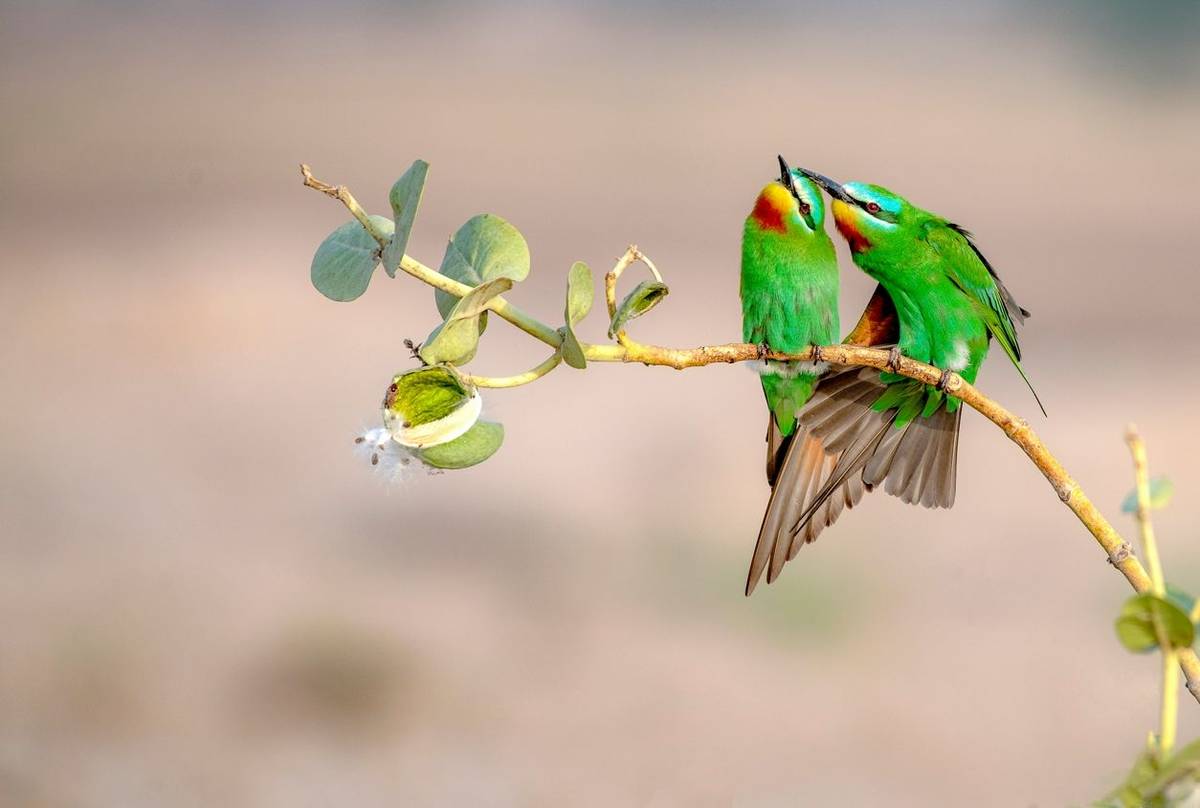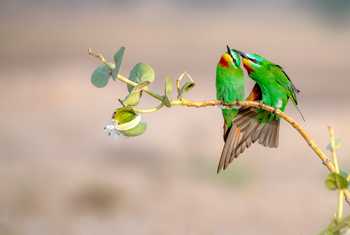This holiday gave us a wonderful insight of Uzbekistan as it encompassed the opportunity to see the wildlife in different terrains (mountain, meadow and desert). We also experienced the amazing buildings & culture in Tashkent, Samarkand and Bukhara, along with visits to local restaurants to enjoy the cuisine. We have travelled with Naturetrek on many occasions and have found them to be reliable, helpful with enquires, and providing excellent pre-tour information. The fact that we are repeat clients speaks for itself!
T.J., Cardiff, May 25



Tour Itinerary and Reports
Can I help you?
Uzbekistan's Wildlife & Culture
Tour Code: UZB01A 10-day tour of Uzbekistan, combining birdwatching with the country’s unique history and culture.
£3,895
£3,295
Highlights
Tour Itinerary and Reports
Can I help you?
Quick Enquiry
Summary
The little-visited country of Uzbekistan is famous for lying along the Silk Road, between Europe and the Orient, and its exotic Central Asian architecture is a marvel to behold. It is also a birding crossroads, where visitors can enjoy a mixture of reassuringly familiar species and exciting newcomers. On this tour we will indulge in the cultural delights of Samarkand and Bukhara, with their subtly different Islamic masterpieces, while also devoting time to birding the mountains, rivers, woods and deserts, each with different specialities. The remarkable, flat desert of Kyzyl Kum is sure to be a highlight.
- An exciting combination of wildlife and culture across a little-known country
- Two days in Za'amin National Park in the western Turkestan Mountains
- Likely bird species include Yellow-breasted (Azure) and Rufous-naped Tit, White-capped Bunting and Lammergeier
- City tour of Samarkand with its astonishing Islamic architecture
- Visits to Kyzyl Kum Desert, with its sand-dunes and Saxaul shrubs, and the Amu-Bukhara canal
- Good chance of seeing the star of the region, the stunning Turkestan Ground-Jay
- Great supporting cast, with Upcher's Warbler, Desert Finch and Asian Desert Warbler
- City tour of historic Bukhara
Uzbekistan is a spectacular and little-visited Central Asian country, lying on the ancient Silk Route that once connected the East with the West. Although much smaller than neighbouring Kazakhstan, it is home to an exceptionally rich history and culture, and an exciting assortment of birds, mammals and other wildlife. From the Islamic architecture of its cities, to its peaceful desert oases, grasslands, wetlands and magnificent mountains, Uzbekistan’s attractions are fascinating and varied. It is a country with much to offer, richly deserving of our attention.
We will begin our holiday with a flight to Tashkent, the capital of Uzbekistan, where we start with a city tour, which will allow us to experience some of the city’s cultural and historical attractions. This is a city full of contradictions — an intriguing blend of old and new, traditional and modern, Soviet and Oriental. All this diversity combines to make Tashkent a fascinating place to visit. The Old Town is a bewildering maze of mud-brick houses and unpaved streets that confuses even the local taxi drivers. Here we will find the historic Hast-Imam Complex, a dense and extensive conglomeration of ornate mosques and mausoleums. One, the Telyashayakh Mosque, houses the Samarkand Kufic Quran, an 8th or 9th century manuscript that is one of the oldest known copies of the Muslim holy book. The newer parts of the city have grids of straight wide streets or avenues, dotted with pleasant parks, gardens and fountains.
From here, we will drive to Za'amin National Park for a 2-night stay. Amongst the dramatic rocky peaks of the western Turkestan Mountains — a UNESCO World Heritage Site — we will explore the alpine meadows and montane forests in search of White-capped and Rock Bunting, Yellow-breasted Tit, Indian Paradise Flycatcher and White-crowned Penduline Tit. We will also keep an eye on the skies where Black, Griffon and Himalayan Griffon Vultures may be seen soaring on the thermals above the snow-capped peaks, alongside various eagle species. Brown Bears also inhabit these remote mountains, and Snow Leopards patrol the higher peaks and valleys, although both species are rare and elusive, however we do hope to see the local race of Siberian Ibex.
Travelling west, we will then spend three nights in the legendary ancient city of Samarkand, one of the earliest continuously occupied settlements in Central Asia. Samarkand is home to some of the world’s oldest madrassas — Islamic educational establishments — and the Gur-Emir, a magnificent 15th century mausoleum that inspired much of the great architecture of the Mogul Empire, including the Taj Mahal. As well as these old Islamic buildings, there are districts with a heavy Russian influence, and an old Jewish Quarter, both of which have their own architectural style and charm. We will take a guided tour to enjoy the city’s cultural and historical highlights, admiring some of the painstakingly crafted monuments, many of which display the region’s distinctive blue tiling, decorative arches and turquoise domes. Amidst this grandeur, Alpine Swifts swoop into their nests in the crevices of the older buildings, and an evening visit to Registan Square may result in the sighting of a European Nightjar or two. We will also visit the Takhta-Karacha Pass, where rocky outcrops and low shrubs may yield White-throated Robin, Eastern Rock Nuthatch, Hume's Lark and Finsch's Wheatear, while overhead Egyptian Vulture can be seen.
Our final destination will be Bukhara, a city whose central buildings are subtler in design than those in Samarkand. During our 2-night stay here we will explore the Kyzyl Kum Desert, named for its red sands, and the Jeyran Eco-centre by the AmuBukhara Canal, where we will hope to find White-tailed Lapwing, Blue-cheeked Bee-eater, Kentish Plover, Collared Pratincole, Clamorous Reed Warbler and possibly Turkestan Ground Jay, along with Turkman Gazelle, Kulan (Asiatic Wild Ass) and a variety of reptiles such as Horsfield’s Tortoise and Steppe Agama Lizard. Each evening we will return to Bukhara, giving us time to admire the local architecture, but we will also devote one afternoon to exploring some of the 140 or so protected structures found throughout the city, including the Ark, Po-i-Kalyan Minaret complex and the Samanid Mausoelum.
Finally, we will return to Tashkent by highspeed train and, after a last night in the city, we must leave this fascinating country at the heart of Asia and board our flight home.
Outline Itinerary

What's Included?
- Flights
- Accommodation:
All accommodation is included in the tour cost.
We will stay in comfortable 3* tourist hotels.
- Food:
All meals are included in the tour cost.
Reviews
-
-
My aim was to gain an understanding of a country I knew very little about, and I certainly did that, amongst a really good group that got along splendidly, all led and organised very well by the trip leaders. Martin was as organised and deeply knowledgeable (about a huge range of topics) as I found him to be on a Morocco trip 2 years ago and I was very happy when I found out he was to be trip leader. Timur worked extremely hard not just to find the wildlife, but also to manage all of the trip logistics - not an easy task which he did very well. I felt very confident in his abilities to lead us through the trip. He is clearly extremely knowledgeable about the local wildlife too.
A.C. London, May25 -
I developed an appreciation for the sights and challenges of the Silk Road and how the associated nomad culture and practices are recognisable even in the present day. Tour leader, Martin, and local guide, Timur, both very knowledgeable, approachable and patient with a diverse set of participants. Timur was really helpful in translating and organising restaurant meals and drinks.
B.O, London, May25 -
Mix of culture and wildlife Bukhara and Samarkand were outstanding. Martin knew about birds butterflies, dragonflies, plants and the history of the region.
C.T, Surrey, May25 -
I really enjoyed this holiday, the combination of seeing the ancient silk road cities as well as all the wildlife this country has to offer, was a great combination. The sightseeing in the evening light in Bukhara after days out birding were a really great encapsulation of the trip. I was really impressed by both leaders. Timur as the local guide not only had the usual expected information on locations to go to but also excellent bird call knowledge but was also obviously in contact with other local birders so knew if birds turned up in unexpected places. He was also a very friendly and affable person to talk, which is also important in a guide. Mike was also very good, great bird spotter and I also appreciate his wide gamut of wildlife knowledge from the expected birds to dragonflies, butterflies and extensive awareness of plants. As someone who enjoys seeing and identifying all aspects of nature I appreciate this, as sometimes leaders only have bird knowledge and it can be a bit limiting for me. The Kyzyl-Kum desert, was a highlight, not only to go and see the range restricted Turkestan ground-jay but I love visiting deserts and seeing the plants and other creatures that you manage to find here. This is because you have to work a bit but are rewarded by unique sightings, in our case three lizard species and a snake.
D.P. Cambridgeshire, May 24 -
Martin and Timur were both great!!! Visiting the historic sites at Samarkand and Bukhara was fantastic. I particularly enjoyed seeing Indian paradise flycatcher, rollers and bee eaters.
R.W. Washington, May 24 -
Great place to visit and couldn't of seen so much in the time available without the Naturetrek guides. Timur was excellent, using sight and hearing to locating all the birds. He slso managed all the accommodation, travel and restaurants very smoothly. Martin is an expert birder and knew the wildlife and cultural sites well. He was nicely laid back and facilitated travel and timings well. The cultural sites are not to be missed. The call and dance of the Eastern Rock Nuthatch was memorable, as were Martin's impersonations of it over the following days. The first sunny clear morning in the mountains (after a long rainy journey) was great, all the target birds being seen in good light.
J.P. Hampshire, May 24 -
Unique holiday covering both the culture and wildlife of Uzbekistan. As well as seeing the marvellous architecture of Bukhara, Tashkent and Samarkand and learning the history of this area, you see the natural world in the different climatic zones this country covers in terms of mountains, deserts and plains. With first class guides and drivers it really was an exceptional trip. Naturetrek consistently provides first class holidays at reasonable prices to interesting part of the world. The back office has always provided first class service and their employees on the ground have never been less than excellent.
J.R. Hampshire, May 23 -
A good mix of both nature & culture - mainly birds of which there were many different varieties and we had some excellent sightings. We followed the Silk Route, so culture was to the fore in all the cities we visited where we had very good and most informative guides.
A.S Buckinghamshire, May 22
Dates & Prices
2026

Tour Leader: Martin Pitt
Martin has had an interest in wildlife since an early age and, although he worked in development and consultancy across the globe, he has always kept this interest going. He has been leading tours for Naturetrek, both in the UK and overseas, since 2017.
Primarily interested in birds and mammals, his time living in the Middle East (a year in the UAE and 2 years in Israel) gave him a deep love of desert ecosystems. More recently, he has spent an increasing amount of time focused on butterflies and dragonflies. He is the author of the ‘Crossbill Nature Guide to Southern Morocco’ and as of 2023 he is also the Bird Recorder for Hampshire.
Martin has led a number of tours, including day trips and weekends in Hampshire and the adjacent areas, as well as tours overseas including Austria, Ethiopia, France, Mexico, Morocco, Poland, Romania, Spain and Uzbekistan.
2027
Prefer to Travel in a Private Group?
For any interested natural history club or society, we can arrange for a private departure of this tour.
Enquire
Why Naturetrek?
At Naturetrek we craft expertly-guided group and tailor-made wildlife holidays and cruises to all seven continents. On one of our holidays, you can be assured that our passionate team will enable you to experience and enjoy the best of the world's wildlife and natural spectacles in as comfortable and rewarding a manner as possible, caring as best we can for the environment in the process. We are proud to provide:
- The widest choice of wildlife holidays worldwide
- Tours managed and led by naturalists, for naturalists
- Outstanding value and exceptional customer service
Furthermore, as a Naturetrek client, our office team are always to on hand to help you – so if you have any queries about your holiday, whether before or after you have booked, we will be delighted to answer them on the phone. Please just give our team a call!



 Loading search...
Loading search...











